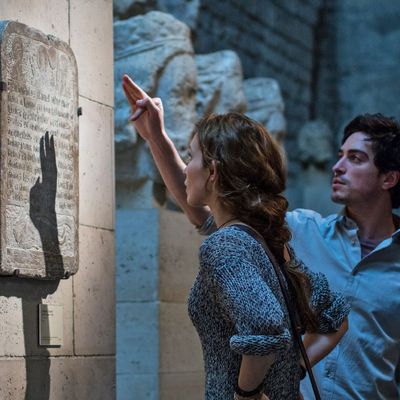
Just when you thought the found-footage horror subgenre was starting to die, As Above, So Below doubles down on it. In so doing, it also demonstrates some of the fundamental limitations of the subgenre. It may even remind you, by way of counterexample, why such films took hold in the first place. Afterwards, I thought fondly back to The Blair Witch Project, Paranormal Activity, and [Rec], wondering what they did so right that As Above, So Below so, so doesn’t.
The setup has promise: Scarlett (Perdita Weeks), a young, beautiful urban archeologist, enlists the aid of a handsome old flame, George (Ben Feldman), and a trio of French adventurers to go down into the Paris catacombs on a quest to find the Philosopher’s Stone. Said stone, if you recall your Harry Potter, is a magic rock that was supposedly used in the practice of alchemy. Scarlett’s own father once went mad and killed himself searching for it. Unfortunately, somewhere down in the catacombs may also lie the doorway to Hell, which is a pretty solid reason not to go there, but no matter. The idea of a journey through miles of dark underground graves is exciting: The film could, in its ideal state, blend the subterranean terror of The Descent and the what’s-that-in-the-corridor-there tension of Session 9, with some appropriately Exorcist-ian mumbo jumbo thrown in.
What happens next? I’m not exactly sure. There’s a lot of screaming, crawling through bones, loud noises, and some falling. Pathways open and then close themselves. The walls groan with loud noises. Or, at least, I think that’s what they do. Scarlett has brought along her friend and cameraman Benjy (Edwin Hodge), and he has the smart idea of attaching pin cameras to everyone’s foreheads, which is a decent way to get around a major roadblock in most found-footage horror: how to motivate the constant presence of cameras when most sane people would have dropped them and run by now. Unfortunately, this doesn’t solve the other major roadblock for this subgenre: how to make it clear to your audience what’s happening onscreen. As Above, So Below seems to have no interest in that. Instead, it dives headlong into shrill incoherence.
Horror thrives on uncertainty, but it also requires some clarity to get there. You may not always recognize the forms onscreen; some of the greatest horror-movie moments are built around things we think we may have seen. But there’s also an unstated contract between filmmakers and audience in these films: that the ambiguity will never break into confusion, that we’re not struggling to understand basic plot points. To put it another way: How can you avert your eyes if you’re constantly straining to see (and understand) what’s happening? As Above, So Below, even more so than most other found-footage films, relies on the misguided notion that loud noises and a lot of incoherent shaky-cam will somehow convince us that we’re experiencing something scary. (Might it have worked years ago, before found-footage horror became a punch line? I don’t know. Back in 2008, director John Erick Dowdle also made Quarantine, the American remake of the Spanish horror flick [Rec], and that was fairly effective. But I don’t recall it being this jumbled.)
There are moments of welcome tension amid the inchoate lunacy, but these in turn merely highlight why the rest of the film doesn’t work. At one point, as our heroes make their way through a narrow passageway piled high with the ancient bones of hundreds of corpses, Benjy gets stuck. Everything stops, and the immobile camera is trained on the face of the character having a claustrophobic panic attack. We can finally focus on the heavy breathing and the terror on the actor’s face, while the stillness of the frame heightens the sense of entrapment. It’s a beautiful, chilling moment. It doesn’t last.


